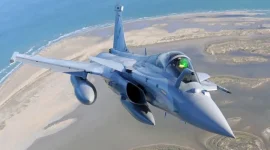- Views: 1K
- Replies: 9
The Indian Air Force (IAF) is undergoing a strategic shift in its approach to long-range strike missions, increasingly favoring air-launched ballistic missiles (ALBMs) over traditional subsonic cruise missiles.
This change is driven by the recognition that even stealthy cruise missiles are becoming more susceptible to interception by modern air defence systems due to their predictable flight paths.
To bolster its deep-strike capabilities, the IAF has integrated the Rampage and ROCKS ALBMs, both sourced from Israel. These missiles are designed to deliver precision strikes against high-value, hardened targets.
Importantly, local production of these missiles is underway, underscoring India's commitment to self-reliance and cost-efficiency in defence procurement.
In addition to incorporating foreign systems, India is actively pursuing the indigenous development of ALBMs. This strategy allows for customization to meet specific operational requirements within the IAF's strategic framework, while also reducing reliance on imports.
ALBMs offer several key advantages over cruise missiles:
- High Speed: Their ballistic trajectory allows ALBMs to achieve significantly higher speeds than cruise missiles, reducing the window for interception and providing a crucial advantage in time-sensitive scenarios.
- Maneuverability: Unlike cruise missiles that follow predictable flight paths, ALBMs can perform evasive maneuvers during their descent phase, making them harder to track and intercept.
- Penetration Capability: The ballistic trajectory also allows ALBMs to penetrate layered air defences, ensuring reliable delivery of ordnance to targets deep within enemy territory, even in the face of heavy electronic warfare.
- Mission Versatility: ALBMs provide the IAF with the flexibility to conduct a wider range of missions, from neutralizing enemy air bases and command-and-control centers to targeting mobile missile launchers.


